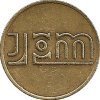Of course as well as the progress made in gaming machine technology by the manufacturers themselves there were also huge developments in the components that were purchased to go in them.
One of the more obvious products to receive such progress was the coin acceptor.
Traditionally the coin acceptor was a metal mechanism dedicated to measuring the circumference, width and solidity of a coin.
It also had a small magnet to detect Ferrous fakes.
One of the new players in the marketplace was Mars, I believe an American company, that introduced their Injection molded Mars mechanism, or Mech.
Obviously it was in their interest to make sure the technicians from the various manufacturers could repair or recognise problems with their product.
So 40 years ago I was invited to Mars in Winnersh triangle in Reading for an introduction to the product.
What I saw there blew my mind.
Although JPM by this time were ensconced in a new building and the materials we used were modern, we still employed the more traditional manufacturing procedures of stores stock holding, stock issue, and handling and transportation of materials to the staff.
Not at Mars.
If you asked the store's manager at Mars exactly where a component was in the stores, he didn't know.
If you were to ask him to get a component he couldn't. No Bin cards here!
The stock holding area was a series of racks, and these were, as I recall some 20 or perhaps even 30 ft high, around 2 ft wide each, with perhaps a 3 foot gap between them and around 100 feet long.
Negotiating and populating this area were a series of computer-controlled robotic stock controllers, a sort of very small telescopic forklift on rails.
As stock arrived it was entered into the computer and then loaded onto plastic bins designed to fit perfectly within the racks. Not all components in the same bin, it really didn't matter because the computer knew where they were.
Once the stock was loaded the computer decided where a suitable space was and took it to its destination, not necessarily next to similar items that we're still in stock.
Similarly to issue stock you simply typed in what you wanted and the controller would go off and bring you your item, after which you would update the quantity and send the remainder back.
It didn't stop there.
Buried beneath the carpet tiles around the workshops were metal tapes and these formed a route that branched off to individual workspaces.
Stock for an individual worker was loaded onto to a battery powered flatbed truck the size of a pallet truck with a flashing light and sensors all around.
The guy loading the truck would choose a destination press the button and off would go this little truck, quite slowly, less than walking pace, and often in convoy with other similar trucks. Once at their destination they would politely chirp to be unloaded and once commanded to return, they made their way back to the stores.
There were other aspects of modern technology their regarding staff access and time keeping etc, but honestly I don't remember them, however the store and stock control stuck in my mind and I thought you guys might be interested.
Don't forget this was 40 years ago!


